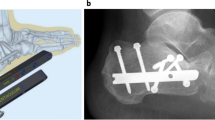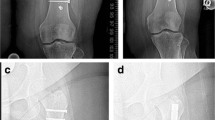Abstract
Background
Interest around carbon/PEEK plates and nails has been raising. The elastic modulus close to the bone, the high load-carrying capacity and radiolucency make CFR/PEEK materials a potential breakthrough. In the literature, there are abundant data about CFR/PEEK plates in the treatment of proximal humerus, distal radius and distal fibula fractures. In patients affected by bone metastasis, CFR/PEEK nails were proved effective and safe with 12 months of follow-up. Very little is known about performances of CFR/PEEK nails in patients affected by other pathologies.
Purposes
The aim of the study was to evaluate safety and efficacy of CFR/PEEK nails in the treatment of various pathological conditions. It was also investigated whatever radiolucency of this nails could lead to a more objective evaluation of bone callus or disease site.
Patients and methods
In the study group were included 20 patients (22 bone segments) who underwent CFR/PEEK nail implantation (eight humerus, one tibia, nine femur and four knee arthrodesis). They were affected by pathological fractures, and in four cases, they required an arthrodesis of the knee. They were retrospectively evaluated considering nail failures and bone callus or disease progression (RUSH scores). Mean follow-up time was 11 months (min 6.8–max 20.3). In the control group were included patients treated with titanium nails in the same institution for the same pathologies. An interclass correlation coefficient (ICC) analysis was performed in both groups considering RUSH scores by two expert surgeon from two institution to assess whether radiolucency could lead to a more objective evaluation of disease or bone callus site.
Results
The ICC of mean values between RUSH scores was 0.882 (IC 95%: 0.702–0.953) in the CFR/PEEK group, while it was 0.778 (IC 95%: 0.41–0.91) in the titanium group. Observers’ evaluation showed a significantly higher obscuration by titanium nails than by CFR/PEEK nails. No osteosynthesis failures were reported in both groups.
Conclusions
Our results confirm the safety of CFR/PEEK nails in the short–medium term. The radiolucency of these materials led our observers to perform more objective evaluations of bone callus formation or disease progression compared to the titanium group given the higher ICC.
Level of evidence: III Case–control therapeutic study.





Similar content being viewed by others
References
Akay M, Asian N (1995) An estimation of fatigue life for a carbon fibre/poly ether ether ketone hip joint prosthesis. Proc Inst Mech Eng 209(2):93–103. https://doi.org/10.1177/0956797614551162
Allal AS, Richter M, Russo M, Rouzaud M, Dulguerov P, Kurtz JM (1998) Dose variation at bone/titanium interfaces using titanium hollow screw osseointegrating reconstruction plates. Int J Radiat Oncol Biol Phys 40(1):215–219. https://doi.org/10.1016/S0360-3016(97)00587-7
Augat P, Morgan EF, Lujan TJ, Macgillivray TJ, Cheung WH (2014) Imaging techniques for the assessment of fracture repair. Injury 45(SUPPL. 2):S16–S22. https://doi.org/10.1016/j.injury.2014.04.004
Bagheri ZS, El Sawi I, Bougherara H, Zdero R (2014) Biomechanical fatigue analysis of an advanced new carbon fiber/flax/epoxy plate for bone fracture repair using conventional fatigue tests and thermography. J Mech Behav Biomed Mater 35:27–38. https://doi.org/10.1016/j.jmbbm.2014.03.008
Baidya KP, Ramakrishna S, Rahman M, Ritchie A (2001) Quantitative radiographic analysis of fiber reinforced polymer composites. J Biomater Appl 15(3):279–289. https://doi.org/10.1106/BKLQ-E2YG-D2LA-RG3R
Bhandari M, Chiavaras M, Ayeni O, Chakraverrty R, Parasu N, Choudur H et al (2013) Assessment of radiographic fracture healing in patients with operatively treated femoral neck fractures. J Orthop Trauma 27(9):e213–e219. https://doi.org/10.1097/BOT.0b013e318282e692
Brockett CL, Carbone S, Fisher J, Jennings LM (2017) PEEK and CFR-PEEK as alternative bearing materials to UHMWPE in a fixed bearing total knee replacement: an experimental wear study. Wear 374–375:86–91. https://doi.org/10.1016/j.wear.2016.12.010
Brown SA, Hastings RS, Mason JJ, Moet A (1990) Characterization of short-fibre reinforced thermoplastics for fracture fixation devices. Biomaterials 11(8):541–547. https://doi.org/10.1016/0142-9612(90)90075-2
Caforio M, Perugia D, Colombo M, Calori GM, Maniscalco P (2014) Preliminary experience with Piccolo Composite™, a radiolucent distal fibula plate, in ankle fractures. Injury 45(S6):S36–S38. https://doi.org/10.1016/j.injury.2014.10.020
Chiavaras MM, Bains S, Choudur H, Parasu N, Jacobson J, Ayeni O et al (2013) The Radiographic Union Score for Hip (RUSH): the use of a checklist to evaluate hip fracture healing improves agreement between radiologists and orthopedic surgeons. Skelet Radiol 42(8):1079–1088. https://doi.org/10.1007/s00256-013-1605-8
Diffo Kaze A, Maas S, Waldmann D, Zilian A, Dueck K, Pape D (2015) Biomechanical properties of five different currently used implants for open-wedge high tibial osteotomy. J Exp Orthop 2(1):14. https://doi.org/10.1186/s40634-015-0030-4
Errani C, Bazzocchi A, Spinnato P, Facchini G, Campanacci L, Rossi G et al (2019) What’ s new in management of bone metastases? Eur J Orthop Surg Traumatol 29(7):1367–1375. https://doi.org/10.1007/s00590-019-02446-y
Errani C, Mavrogenis AF, Cevolani L, Spinelli S, Piccioli A, Maccauro G et al (2017) Treatment for long bone metastases based on a systematic literature review. Eur J Orthop Surg Traumatol 27(2):205–211
Feerick EM, Kennedy J, Mullett H, FitzPatrick D, McGarry P (2013) Investigation of metallic and carbon fibre PEEK fracture fixation devices for three-part proximal humeral fractures. Med Eng Phys 35(6):712–722. https://doi.org/10.1016/j.medengphy.2012.07.016
Filippiadis D, Mavrogenis AF, Mazioti A (2017) Metastatic bone disease from breast cancer: a review of minimally invasive techniques for diagnosis and treatment. Eur J Orthop Surg Traumatol 27(6):729–736
Fujihara K, Huang ZM, Ramakrishna S, Satknanantham K, Hamada H (2003) Performance study of braided carbon/PEEK composite compression bone plates. Biomaterials 24(15):2661–2667. https://doi.org/10.1016/S0142-9612(03)00065-6
Haque S, Siddiqui G (2011) Re: The invisible nail: a technique report of treatment of a pathological humerus fracture with a radiolucent intramedullary nail. Injury 42(11):1390–1391. https://doi.org/10.1016/j.injury.2011.05.026
Hillock R, Howard S (2014) Utility of carbon fiber implants in orthopedic surgery: literature review. Reconstruct Rev 4(1):23–32. https://doi.org/10.15438/rr.v4i1.55
Howling GI, Sakoda H, Antonarulrajah A, Marrs H, Stewart TD, Appleyard S et al (2003) Biological response to wear debris generated in carbon based composites as potential bearing surfaces for artificial hip joints. J Biomed Mater Res Part B Appl Biomater 67(2):758–764. https://doi.org/10.1002/jbm.b.10068
Jockiseh KA, Brown SA, Bauer TW, Merritt K (1992) Biological response to chopped-carbon-fiber reinforced peek. J Biomed Mater Res 26:133–146
Katthagen JC, Ellwein A, Lutz O, Voigt C, Lill H (2017) Outcomes of proximal humeral fracture fixation with locked CFR-PEEK plating. Eur J Orthop Surg Traumatol 27(3):351–358. https://doi.org/10.1007/s00590-016-1891-7
Koch KM, Hargreaves BA, Pauly KB, Chen W, Gold GE, King KF (2010) Magnetic resonance imaging near metal implants. J Magn Reson Imaging JMRI 32(4):773–787. https://doi.org/10.1002/jmri.22313
Koff MF, Shah P, Koch KM, Potter HG (2013) Quantifying image distortion of orthopedic materials in magnetic resonance imaging. J Magn Reson Imaging 38(3):610–618. https://doi.org/10.1002/jmri.23991
Kurtz SM, Devine JN (2007) PEEK biomaterials in trauma, orthopedic, and spinal implants. Biomaterials 28(32):4845–4869. https://doi.org/10.1016/j.biomaterials.2007.07.013
Li CS, Vannabouathong C, Sprague S, Bhandari M (2014) The use of carbon-fiber-reinforced (CFR) peek material in orthopedic implants: a systematic review. Clin Med Insights: Arthritis Musculoskel Disorders 8:33–45. https://doi.org/10.4137/CMAMD.S20354
Lill H, Hepp P, Korner J, Kassi JP, Verheyden AP, Josten C, Duda GN (2003) Proximal humeral fractures: how stiff should an implant be? A comparative mechanical study with new implants in human specimens. Arch Orthop Trauma Surg 123(2–3):74–81. https://doi.org/10.1007/s00402-002-0465-9
Mavrogenis AF, Vottis C (2014) PEEK rod systems for the spine. Eur J Orthop Surg Traumatol 24:111–116
Morshed S (2014) Current options for determining fracture union. Adv Med 2014:1–12. https://doi.org/10.1016/j.brainresrev.2006.12.007
Piccioli A, Piana R, Lisanti M, Di Martino A, Rossi B, Camnasio F et al (2017) Carbon-fiber reinforced intramedullary nailing in musculoskeletal tumor surgery: a national multicentric experience of the Italian Orthopaedic Society (SIOT) Bone Metastasis Study Group. Injury 48:S55–S59. https://doi.org/10.1016/S0020-1383(17)30659-9
Postlethwaite KR, Philips JG, Booth S, Shaw J, Slater A (1989) The effects of small plate osteosynthesis on postoperative radiotherapy. Br J Oral Maxillofac Surg 27(5):375–378. https://doi.org/10.1016/0266-4356(89)90076-4
Schliemann B, Hartensuer R, Koch T, Theisen C, Raschke MJ, Kösters C, Weimann A (2015) Treatment of proximal humerus fractures with a CFR-PEEK plate: 2-year results of a prospective study and comparison to fixation with a conventional locking plate. J Shoulder Elbow Surg 24(8):1282–1288. https://doi.org/10.1016/j.jse.2014.12.028
Scholes SC, Unsworth A (2009) Wear studies on the likely performance of CFR-PEEK/CoCrMo for use as artificial joint bearing materials. J Mater Sci Mater Med 20(1):163–170. https://doi.org/10.1007/s10856-008-3558-3
Skinner HB (1988) Composite technology for total hip arthroplasty. Clin Orthop Relat Res 235:224–236. https://doi.org/10.1097/00003086-198810000-00022
Stefano B, Tedesco G, Ming L, Ghermandi R, Amichetti M, Fossati P, Krengli M, Mavilla L, Gasbarrini A (2018) Carbon-fiber-reinforced PEEK fixation system in the treatment of spine tumors: a preliminary report. Eur Spine J 27(4):874–881
Steinberg EL, Rath E, Shlaifer A, Chechik O, Maman E, Salai M (2012) Carbon fiber reinforced PEEK Optima-A composite material biomechanical properties and wear/debris characteristics of CF-PEEK composites for orthopedic trauma implants. J Mech Behav Biomed Mater 17:221–228. https://doi.org/10.1016/j.jmbbm.2012.09.013
Tarallo L, Mugnai R, Adani R, Zambianchi F, Catani F (2014) A new volar plate made of carbon-fiber-reinforced polyetheretherketon for distal radius fracture: analysis of 40 cases. J Orthop Traumatol 15(4):277–283. https://doi.org/10.1007/s10195-014-0311-1
Tedesco G, Gasbarrini A, Bandiera S, Ghermandi R, Boriani S (2017) Composite PEEK/Carbon fiber implants can increase the effectiveness of radiotherapy in the management of spine tumors. J Spine Surg 3(3):323–329. https://doi.org/10.21037/jss.2017.06.20
Utzschneider S, Becker F, Grupp TM, Sievers B, Paulus A, Gottschalk O, Jansson V (2010) Inflammatory response against different carbon fiber-reinforced PEEK wear particles compared with UHMWPE in vivo. Acta Biomater 6(11):4296–4304. https://doi.org/10.1016/j.actbio.2010.06.002
Wilson WK, Morris RP, Ward AJ, Carayannopoulos NL, Panchbhavi VK (2015) Torsional failure of carbon fiber composite plates versus stainless steel plates for comminuted distal fibula fractures. Foot Ankle Int 37(5):548–553. https://doi.org/10.1177/1071100715625291
Xin-Ye N, Xiao-Bin T, Chang-Ran G, Da C (2012) The prospect of carbon fiber implants in radiotherapy. J Appl Clin Med Phys 13(4):152–159. https://doi.org/10.1120/jacmp.v13i4.3821
Zimel MN, Hwang S, Riedel ER, Healey JH (2015) Carbon fiber intramedullary nails reduce artifact in postoperative advanced imaging. Skelet Radiol 44(9):1317–1325. https://doi.org/10.1007/s00256-015-2158-9
Author information
Authors and Affiliations
Corresponding author
Ethics declarations
Conflict of interest
Each author certifies that he or she has no commercial associations (e.g. consultancies, stock ownership, equity interest, patent/licensing arrangements, etc.) that might pose a conflict of interest in connection with the submitted article.
Additional information
Publisher's Note
Springer Nature remains neutral with regard to jurisdictional claims in published maps and institutional affiliations.
Rights and permissions
About this article
Cite this article
Sacchetti, F., Andreani, L., Palazzuolo, M. et al. Carbon/PEEK nails: a case–control study of 22 cases. Eur J Orthop Surg Traumatol 30, 643–651 (2020). https://doi.org/10.1007/s00590-019-02602-4
Received:
Accepted:
Published:
Issue Date:
DOI: https://doi.org/10.1007/s00590-019-02602-4




